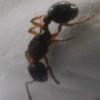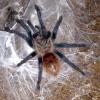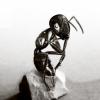Here are some crappy pics that I took yesterday evening. Everything is quite blurry but I don't want to disturb them in the fungus just to take some pictures (on top of that, that'd probably mess with their humidity control which is never a good thing for the fungus...).

Here is the forage area, where I had put some red/white cabbage, some oat and some salad. It took them 4 hours to get rid of nearly everything. This weekend they'll have some raspberry leaves, since it's always been the most successful stuff.

Here is the fungus, but you won't see much, since there is so much humidity and leaves residue on the surface of the plastic.

And here is some yummy garbage disposal, which I should definitely clean, but I'm always delaying the inevitable.
Edited by Sisyphe, January 30 2016 - 8:01 AM.
My colonies:
European species: Lasius niger (1 colony and dozens of fundations), Lasius emarginatus (foundation), Lasius flavius (foundation), Messor barbarus (foundation), Messor capitatus (colony), Messor minor hesperius (colony), Pheidole pallidula (colony), Camponotus cruentatus (colony), Camponotus barbaricus (colony), Camponotus ligniperdus (foundation), Formica lemani (foundation), Formica cinerea (foundation)
Asian species: Pheidole noda (mature colony), Camponotus nicobarensis (colony), Polyrachis dives (foundation)
South American species: Acromyrmex echinatior (huge colony)
























